U.S. Department of Transportation
Federal Highway Administration
1200 New Jersey Avenue, SE
Washington, DC 20590
202-366-4000
FHWA Course on Bicycle and Pedestrian Transportation
Slideshow for Instructors' Use
Slideshow Script: Pedestrian Planning and Design
- PowerPoint Word Slide (title): Planning and Designing Pedestrian Facilities
- PowerPoint Word Slide: Why should we accommodate pedestrians?
- There are 56 million walking trips in the US everyday (7.2% of all
trips)
- One in ten US households do not own an automobile
- 1/3 of population do not drive an automobile
- Everyone is a pedestrian at some point during their trip
Explanation:
(Go through each bullet, elaborate on bullet #3) A sizeable number of
US citizens do not drive because they are too young, or are adults who
for whatever reason do not choose to drive (perhaps due to a disability
or by choice), or are elderly citizens who are no longer able to drive.
References: References: Uniform Vehicle Code, 1995 National Personal Transportation
Survey (NPTS), 1990 US Census
- PowerPoint Word Slide:
More reasons:
There should be other options than driving for short trips
Better environment
- reductions in air pollution and traffic congestion
- decreased need for roadway infrastructure; less stormwater runoff;land would be conserved
- PowerPoint Word Slide:
And still more reasons:
- Better health:60% of Americans lead completely sedentary lifestyles,40% are clinically overweight
- Better safety: over 5200 pedestrians killed and 69,000 injured per year
(1998 figures) in motor-vehicle-related crashes.
References: National Highway Traffic Safety Administration, 1998 American
Medical Association Report
- PowerPoint Word Slide: Federal Goals for Bicycling
Set by USDOT in National Bicycling and Walking Study (1994):
- Double the percentage of total trips made by bicycling and walking(from 7.9 to 15.8%)
- Simultaneously reduce by 10% the number of bicyclists and pedestrians killed
or injured in traffic crashes
- PowerPoint Word Slide:Federal Legislation
- ISTEA - Intermodal Surface Transportation Efficiency Act (1991)
- TEA 21 - Transportation Equity Act of the Twenty-first Century
Explanation:
Bicycle and pedestrian facilities are eligible for funding through the
Enhancements program, which (in both ISTEA and TEA-21) sets aside 10%of
federal Surface Transportation funds for ten categories of "enhancements"which
also include scenic byways, historical transportation facilities,etc.
Reference: FHWA-P1 98-049: A Summary: Bicycle Pedestrian Provisions of
the Federal -Aid Program
- PowerPoint Word Slide (title): Zoning and Subdivision Design Practices:Effects on Pedestrian Mobility
- Photo Slide: Aerial view of residential cul-de-sac development/residential
street
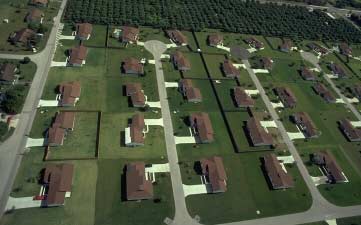
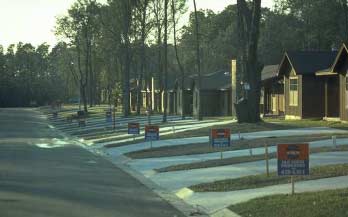
Explanation:
This is what most US suburban residential developments look like today. Of
course, the history of transportation and land use in this country can provide
an explanation for why our communities no longer encourage or accommodate
pedestrians. During the Industrial Revolution, single-use zoning was introduced
in order to buffer residential areas from unpleasant and noxious adjacent
land uses. As automobiles became more commonly used for transportation and
the streetcar was phased out, houses moved back from the street. People began
to use automobiles to reach more and more destinations, even those that were
close to home. As traffic became a problem, cul-de-sacs were developed to
reduce through-traffic on residential streets. This is the result: enclaves
of housing that are separated from commercial areas by high speed, heavily
traveled arterial roadways.
Unfortunately, suburban residential areas have lost the character that they
once had. Houses all look the same – often the garage is the most prominent
thing on the front of the house. There are no sidewalks or street trees,and
the streets are extremely wide.
- Photo Slide:Residential street - Birmingham, AL
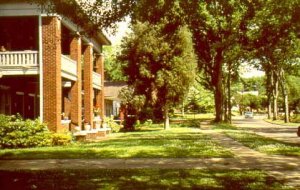
Explanation:
It wasn't always this way. Older communities were designed to be far more
pedestrian-friendly, because people relied so much more on walking (people
actually walked to the store and other destinations). Older developments tended
to have a mixed land use of commercial and residential properties. This is
now some of the hottest real estate in the US
- Photo Slide:Arterial through a strip developed area
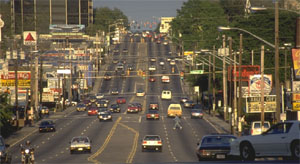
Explanation:
The result of our land use and transportation policies over the past 50 years
has been to create shopping areas that look like this. People can't walk between
adjacent developments because of fences, ditches, hedges and other barriers.
There are a variety of barriers to walking in this photograph -besides just
the physical discomfort of walking next to seven lanes of traffic,pedestrians
also must get around the light poles which are located in the center of the
sidewalk, the lack of any accommodations at intersections to enable pedestrians
to comfortably cross, and many other physical barriers.
- Photo Slide:Aerial shot of parking lot

Explanation:
Another problem is created by "big box" storefronts that are separated
from the roadway by large parking lots designed for peak holiday season shopping
volumes. Very few people walk to these places - and not just because of the
distance factor. Even if you lived across the street from the development
in this picture, you'd have a tough time getting to it on foot. Entrance intersections
are designed to carry large volumes of turning traffic and have no provisions
for pedestrian crossings, there are no sidewalks on-site, and it is very difficult
to get from the out parcel buildings (like restaurants)to the shopping center.
Malls and strip shopping centers are typically located in areas with low land-use
densities, and they not only lack pedestrian facilities to connect to surrounding
land uses, they often do not provide on-site walkways to make trip from the
car to the store safe.
- Photo Slide:Wide intersection on arterial road
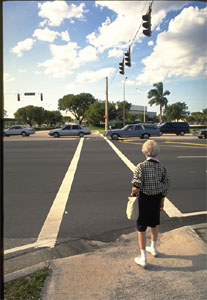
Explanation:
Some intersections are vast, and are timed for optimum traffic flow. Crosswalks
do not solve the problem of getting a pedestrian across the street if one
has to cross 120' of pavement and the signal phasing does not adequately accommodate
pedestrians. Four feet per second walking speed is average, however there
is a trend to use slower walking speeds (such as 3 - 3.5 feet per second)in
order to better accommodate older people and people with disabilities. At
4 feet per second, the pedestrian phase would be 30s (WALK plus flashing DON'T
WALK). At 3 feet per second, the pedestrian phase would be 40s (WALK plus
flashing DON'T WALK).
There are several important things to remember when designing intersection
signals:
- Consider your audience: do you anticipate a fair number of pedestrians who
may walk at a slower speed?
- Crosswalks and medians should be located so that pedestrians can use
the median as a refuge area, in the event that he or she is unable to
make a complete crossing and has to wait in the middle.
Another thing to think about: do you think an older person with declining vision
will be able to see the pedestrian signal head on the other side of this intersection?
- Photo Slide:Downtown street
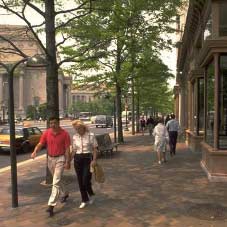
Explanation:
There is a trend towards revitalizing downtowns and making new commercial
development more closely resemble the pedestrian-friendly shopping districts
of earlier times. Trees, landscaping, and human-scale lighting not only enhance
the street, they provide a physical and psychological buffer between the pedestrians
and traffic.
- Photo Slide:Renovated commercial development (FL)
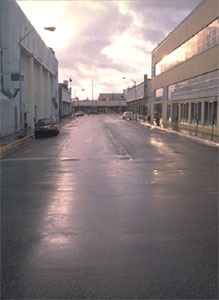
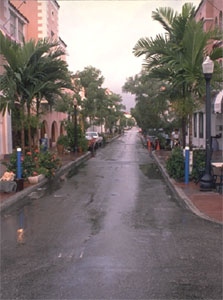
Explanation:
Communities have also begun to provide incentives to developers to renovate
older commercial strip centers. There are some excellent success stories.
For example, an older commercial development in Florida (picture on the left)was
renovated to look like this (picture on the right). Narrow streets, decorative
side walks, landscaping buffers and human scaled lighting make this street
more pedestrian-friendly.
- Photo Slide:Neotraditional neighborhood - Abacoa, FL
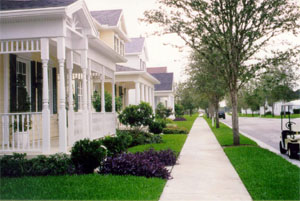
Explanation:
Neotraditional neighborhood design (also called new urbanism) is a "new"style
of community design that uses design principals from 18th and 19th
century American and European towns. Land uses are more compact and mixed,
creating the potential for short walking trips. The architecture in many of
these neighborhoods is often traditional, with wide front porches and garages
out back, connecting to streets via alleyways (thereby eliminating driveways
in front of the houses). Streets are narrower, and arranged in a grid pattern
to disperse vehicular traffic. Wide sidewalks and street trees are on both
sides of the road.
- PowerPoint Word Slide (title): Accommodating Pedestrians with Disabilities
- Photo Slide:Woman with cane on a sidewalk
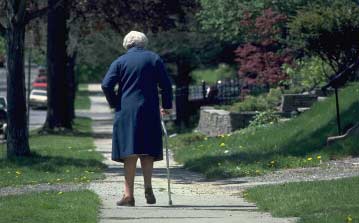
Explanation:
Before we launch into pedestrian design issues, it is important to understand
the Americans with Disabilities Act of 1990, and how this law influences pedestrian
facility design. The ADA has greatly improved sidewalk design and is the reason
why more and more sidewalks and public spaces are barrier-free. ADA not only
improves conditions for disabled pedestrians, but makes sidewalks and intersections
better for all users.
- Photo Slide:Blind pedestrian

Explanation:
ADA is a comprehensive civil rights law that covers employment, education,
housing, communications, health care and transportation. The ADA requires
that the transportation system be accessible and barrier free to all people
with disabilities. A barrier free pedestrian system is particularly important
to people with disabilities because other forms of transportation may not
be optional or available.
- Photo Slide:Man in wheelchair

Explanation:
A barrier free system for a person using a wheelchair is free of physical
obstacles, and for a person who is blind, accessible information such as audible
signals and detectible warnings at intersections.
- Photo Slide:Group of people, some with disabilities
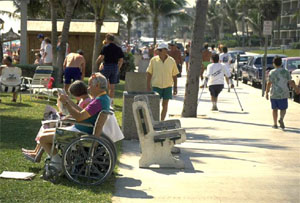
Explanation:
Besides the fact that the Americans with Disabilities Act is a law, why dowe
want to design pedestrian facilities so that they accommodate people with
disabilities? Because it is estimated that approximately 70% of all Americanswill
have a disability at some point in their lifetime, either temporarily or permanently.
Modern medicine has enabled more people with disabilities to lead longer lives,
and when you add that to the fact that the American population is aging, you
can see why this is so important. Odds are, most of us in this room will experience
some type of disability in the future.
Reference:Washington Department of Transportation
- PowerPoint Word Slide (title): Pedestrian Facility Design
- PowerPoint Word Slide:
Sidewalk Design
- Minimum width: 5' (per AASHTO)
- Minimum clear path of travel (with no obstructions):36"
- Desired running slope:no more than 5%
- Maximum grade of a ramp:8.3%
- Maximum cross slope:2% Firm, smooth, slip resistant surfaces
Explanation:
Sidewalk design is influenced heavily by ADA and AASHTO – the US has finally
begun the process of standardizing sidewalk design, much in the same way
as we have standards for roadway design. The Americans with Disabilities
Act is the legal foundation for the Access Board's Accessibility Guidelines –
they define basic design practices that enable people with disabilities
to be able to travel on foot or by wheelchair. Since the ADA is law, these
design guidelines carry quite a bit of weight. The list in this slide
provides just a few of the most basic sidewalk design principals.
(Additional explanation for third and fourth bullets)
Accessibility guidelines recognize that sometimes it is not possible to
meet these slope requirements along public sidewalks and shared-use paths,where
running slope is tied to roadway gradient and underlying terrain. Still,
running slope should be kept to the minimum feasible, since steep slopes
have an extremely detrimental effect on people with disabilities.
- Photo Slide:Sidewalk next to highway
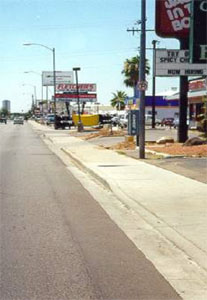
Explanation:
Sidewalks are certainly a critical first step in accommodating pedestrians,but
a lot of other design features are important if you want to encourage walking.
(Case in point – this sidewalk provides a place for people to walk, but very
few people would feel comfortable in this location.) You need to provide pedestrians
a sense of protection from the adjacent roadway. There are a number of ways
to do this:
- Photo Slide: Sidewalk with street trees
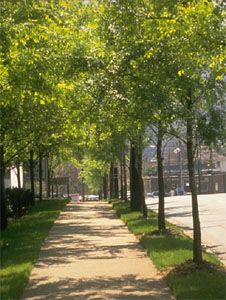
Explanation:
It is amazing how different a sidewalk feels with street trees. They serve
as a very effective buffer from traffic when they are located in the grass
strip between the sidewalk and the curb. This requires a minimum of a 5' planting
strip, although wider planting strips may be needed on roadways with faster
vehicle speeds. The choice of tree species is important – shade trees are
far more effective than small ornamental tree. Trees that branch from the
bottom or shrubs that are too tall can cause a sight distance problem: the
motorists may not see the pedestrian and vice versa.
Although trees have been shown to provide amount of comfort to the pedestrian,there
are some tradeoffs. They require space, which is sometimes very limited in
urban areas. You also need to consider the functional class of the roadway-
trees can pose roadside hazards if they are too close to a high speed roadway.
- Photo Slide:Sidewalk 20' off edge of the road
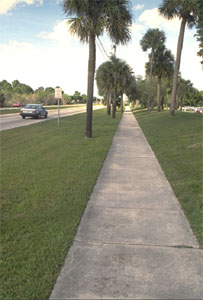
Explanation:
A wider separation between the street and sidewalk can also improve pedestrians'
sense of comfort.
- PowerPoint Word Slide (title): Intersection Design for Pedestrians
- Photo Slide: Sidewalk next to parking lane
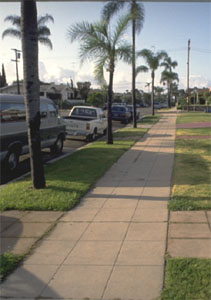
Explanation:
Parking lanes provide a very effective buffer between pedestrians and traffic.
- Photo Slide: Aerial of large urban intersection
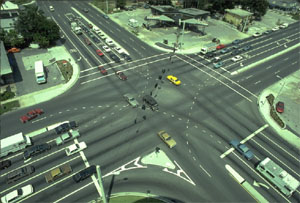
Explanation:
Intersections are the most challenging aspect of pedestrian facility design.
A variety of improvements could make this intersection safer for pedestrians.
Can you list all the things that are make this intersection difficult for
pedestrian crossings?
- Vast distances to cross (80' to 100'), and possibly not enough time to make
it because signals aren't timed for pedestrians.
- Right turn slip lanes - right turning traffic may not be required to stop
- Some older pedestrians or pedestrians that are visually impaired can't see
traffic signals to know when they can get across
- Visibility problems: sign poles, utility boxes, etc. block visual access
between motorists and pedestrians.
- Fast turning traffic: corner turning radii are wide, making it easy for motorists
to maintain higher speeds when turning.
- Crosswalk markings are only on two legs of the intersection. How does the
pedestrian get to the south quadrant?
- Crosswalk is not near the median, denying the pedestrian of a refuge from
traffic while crossing.
- PowerPoint Graphic Slide: Pedestrian exposure due to very large radii
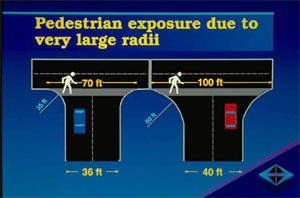
Explanation:
Intersection solutions: create narrower distances for pedestrians to cross
at intersections. One way is to design corner curb returns with a tighter
radius. This also has the effect of slowing down turning traffic. One must
also consider the amount of heavy trucks that use the intersection - since
they may ride over the curb if the radius is too tight.
- Photo Slide: Pedestrians starting to cross intersection
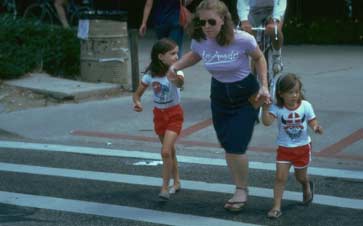
Explanation:
Designers have typically used an average walking speed of 4' per second in
designing pedestrian accommodations, specifically in signal timing, at intersections.
There is a growing tendency to use 3.5' per second, or 3' per second to accommodate
older adults, school children, and people with disabilities. By using slower
walking speeds in intersection design, it allows for a longer green time (crossing
time) for pedestrians.
- Photo Slide: Aerial shot of intersection with curb bulb-outs
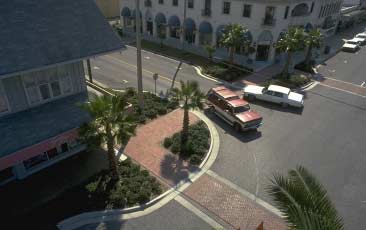
Explanation:
Another solution is to build curb extensions (also called bulb-outs) that
narrow the distance across the intersection. This is an example of a curb
extension that has been combined with decorative crosswalks to enhance pedestrian
visibility.
- Photo Slide: Aerial shot of intersection with curb bulb-outs

Explanation:
Bulb-outs can be especially helpful in locations with on-street parking -the
bulb-out extends out into the intersection so that pedestrians can see past
parked cars. In this example, the extra sidewalk space is used to include
a street lamp, improving pedestrians' visibility at night.
- Photo Slide: Medians and pedestrian refuge islands on an arterial
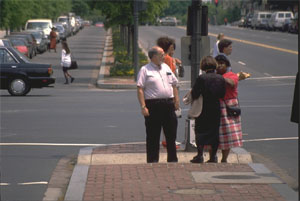
Explanation:
Medians and pedestrian refuge islands allow pedestrians to cross one direction
of traffic at a time, and provide a protected waiting area prior to getting
across the next segment. This is a good solution for large urban intersections.
Intersections on heavily traveled urban corridors are often timed in sequence
to reduce traffic backups, therefore it may be difficult or impossible to
create one signal phase long enough for pedestrians to cross the entire width
of the intersection without causing other parts of the system to fail.
Median refuge islands should have a curb cut on the island so that a person
in a wheelchair can pass through (36" minimum). If the cut is too wide,a
blind cane user may not be able to detect it, thus not know there is a refuge.
- Photo Slide: Aerial shot of a median refuge on a major roadway

Explanation:
This solution can work on roads with extremely high volumes of traffic, as
well as on quieter streets such as this one. In this example, the pedestrian
refuge is part of a landscaped median that extends the length of the roadway.
This style of crosswalk also offers good contrast for people with low vision.
- Photo Slide: Aerial shot of an intersection with colored crosswalks
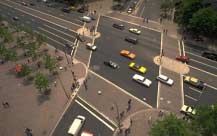
Explanation:
Another solution - increase motorists' awareness of pedestrians by using colored,textured
surfaces in crosswalks. This can be used on major streets like this one. It
is important to make sure that the material used is not slippery,and that
it maintains its stability next to the adjacent pavement.
- Photo Slide: Aerial shot of an intersection with colored crosswalks
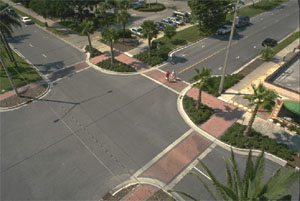
Explanation:
This photo shows the same solution on a quieter street, combined with curb
bulb-outs.
- Photo Slide: Aerial shot of Birmingham, AL intersection

Explanation:
In this example, the entire intersection has been paved with concrete, with
brick avers at the crosswalks. (Five Points intersection in Birmingham,AL)
- Photo Slide: Aerial view of continental-style crosswalks
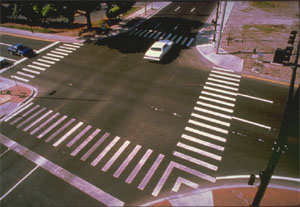
Explanation:
Some types of crosswalk markings are more visible than others and can help
to draw attention to pedestrian crossings. The continental-style crosswalk
can be used when a high level of visibility is desired. This style as well
as the ladder and zebra marking styles are known as high-visibility crosswalks.
- Photo Slide: Pedestrian yellow-green warning sign
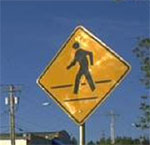
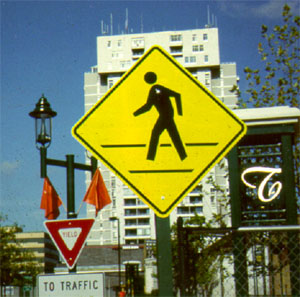
Explanation:
Warning signs can help, too. Keep in mind that they are often ignored by motorists
and, like crosswalks, should be used in conjunction with other pedestrian
improvements at intersections. This is a new sign that is being used in more
and more locations in the US - it's a standard Pedestrian Warning sign (W11-2)with
a bold fluorescent yellow/green color.
- Photo Slide: Pedestrian signal indication

Explanation:
Pedestrian signals can be confusing, particularly at crowded urban intersections
with multiple signal heads. It has been well documented that many pedestrians
do not understand the meaning of pedestrian signals and indications, particularly
the flashing DON'T WALK signal.
- Photo Slide: Pedestrian push button
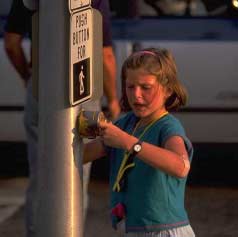
Explanation:
A pedestrian push button is a device that send a call for the pedestrian phase
of the signal to occur. Pedestrian push-buttons are appropriate where occasional
pedestrian movements occur and adequate opportunities do not exist for pedestrians
to cross. Pushbuttons may also be used with pedestrian signals to more quickly
provide a WALK interval and extend the WALK time for pedestrian crossing.
Where no pedestrian signals are present, actuation of the pushbuttons maybe
used to extend the green phase to allow pedestrians sufficient crossing time.
It is important to remember that, in order for a person who is blind to know
that the signal has been changed and it is permissible to cross, they must
have cues. Cues are provided by the sound of moving traffic and also by accessible
pedestrian signals. Keep in mind that the use of multi-phased signals makes
it increasingly difficult for pedestrians that are blind to detect when it
is time to cross. More and more cities across the US are installing accessible
pedestrian signals.
- Photo Slide: Close up:Pedestrian push button
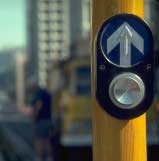
Explanation:
The push button should be in an accessible location and height for a person
in a wheelchair, and should be designed so that it can be easily pushed. Instructional
face plates should include Braille lettering and/or other raised markings
(notice the raised arrow in this photograph).
- Photo Slide:Instructional sign at pedestrian signal
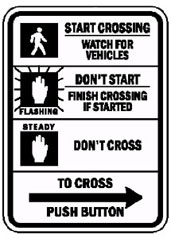
Explanation:
This is one example of an educational sign for a pedestrian signal display. (R10-3b from MUTCD.)
- Photo Slide: People waiting out in the middle of the road
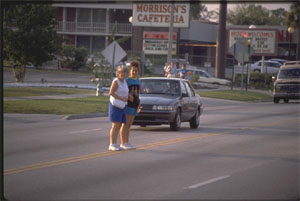
Explanation:
Pedestrians often need to get to the other side of the street, and there isn't
always a convenient intersection nearby. People on foot do not like to take
detours - they will almost always take the most direct route, even if it means
crossing in a dangerous location.
- Photo Slide: Aerial view mid-block crossing
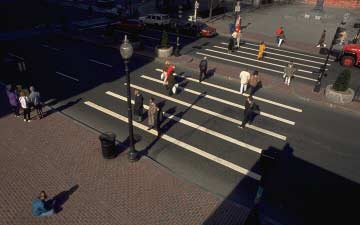
Explanation:
This is a good example of a location where a midblock crossing was needed.
Without a midblock crossing at this location, a pedestrian would have to walk
an extra half mile to get to the other side of the road. In locations like
this, the best approach is to make the crossing as visible as possible so
that motorists know they may encounter pedestrian crossings. At the crossing
location a pedestrian crossing sign (W11-2) is required and if the crossing
location is not marked with a crosswalk, the crossing sign shall be supplemented
with a diagonal pointing arrow plaque (W16-7P). It is also a good idea touse
an appropriate advance warning sign such as the Pedestrian Warning Sign(W11-2)
with supplemental plaques with the legend "AHEAD" or text indicating
distance to the crosswalk to provide advance notice to drivers.
- Photo Slide: Aerial view of man in mid-block crossing
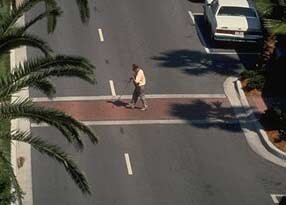
Explanation:
You can use the same measures described earlier for intersections to make
mid-block crossings safer. Colored, textured crosswalks, curb bulb-outs (pinchpoints),
speed tables, median refuges, etc. (These techniques are also called traffic
calming – which is covered later in this slideshow.)
- Photo Slide: Wheelchair on driveway ramp
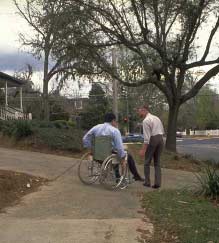
Explanation:
ADA requirements affect driveway design. Disabled pedestrians – particularly
those in wheelchairs – have a very difficult time negotiating cross slopes
that are greater than 2%. Steeper cross slopes can cause a wheelchair to tip
over. A sidewalk (such as the one in this photo) that crosses a steep driveway
can cause the person in the wheelchair to lose control and veer towards the
street.
- PowerPoint Graphic Slide: Driveway Design
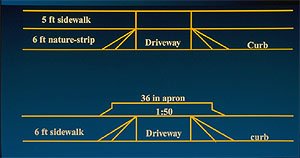
Explanation:
Accessible driveway design requires that the sidewalk cross the driveway at
a level area, with a cross slope that is no steeper than 1:50 or 2%. This
is easier to do when the sidewalk and roadway are separated by a planting
strip.
- Photo Slide: Sidewalk that curves up to meet driveway at a level area

Explanation:
These requirements can be hard to meet if the sidewalk is immediately adjacent
to the curb. This photo shows one solution - swing the sidewalk away from
the curb so that it meets the driveway at a level area.
- Photo Slide: Aerial shot of intersection

Explanation:
ADAAG includes comprehensive guidelines on installing curb ramps at intersections.
These requirements cover both the placement of the ramps at the curb and theirrelationship
to crosswalk markings in the intersection. Perpendicular curb ramps (i.e.
two per corner, each leading into their own respective crosswalks,like the
ones shown in this photograph) are preferred over diagonal curb ramps. Diagonal
curb ramps direct pedestrians toward the center of the intersection,and often
do not actually connect to the crosswalks.
- Photo Slide: Truncated domes

Explanation:
It is also important to understand that curb ramps actually can cause problems
for pedestrians who are blind, if they aren't designed correctly. Curb ramps
provide a gradual slope down to the street, therefore people who are blindor
have other sight problems have a hard time detecting the edge between the
street and the sidewalk. One solution is to use a high contrasting color(such
as yellow) to help people with vision impairments identify the location of
the curb ramp, and also to provide a slightly bumpy surface (such as the ramp
shown in this photo) so that a blind pedestrian can detect the bottom of the
ramp with a cane. These are called "truncated domes."
- PowerPoint Word Slide (title): Traffic Calming
Explanation:
Traffic calming is a term used to describe ways of encouraging slower speeds
and reducing cut-through traffic through physical modifications to the street
environment.
- PowerPoint Graphic Slide: A Traffic Calmed Neighborhood
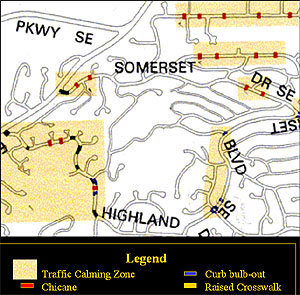
Explanation:
One important thing to remember about traffic calming is that it is more successful
if it is part of an integrated network of solutions. To be successful, it
requires a comprehensive approach to traffic problems in an area. One speed
hump used as a lone traffic calming device cannot be expected to solve speeding
problems. The best approach is to use a combination of devices.
- Photo Slide: Long, straight, wide street
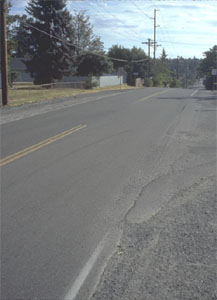
Explanation:
One of the main goals of traffic calming is to improve the "feel"of
the street, making it more comfortable for pedestrians, and less comfortable
for speeding motorists. A central principal of traffic calming is to visually
narrow the street and eliminate long vistas so that motorists are encouraged
to slow down. Wide, straight streets like this one encourage higher speeds.
- Photo Slide: Street with narrower painted lanes and a median
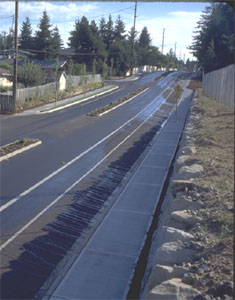
Explanation:
One relatively simple traffic calming method is to "narrow" the
street In this solution, the pavement markings and a median are used to visually
narrow the street. In this example, they were able to narrow the lanes to
11' wide, and provide 5' wide bike lanes on both sides. The median in the
center helps to slow down traffic, and also provides a refuge area for pedestrians
(this is not the best example of this since there is no place on this landscaped
median for pedestrians to stand).
A more effective means of slowing motor vehicle traffic is by causing a lateralor vertical shift in the vehicle path as shown in the following slides:
- PowerPoint Graphic Slide: Speed Hump/Speed Table

Explanation:
Speed humps are elongated speed bumps. Speed humps have a parabolic cross
section (see bottom right cross section), while speed tables have a flat top.
Humps and tables normally have a height of no more than 3 to 3 1/2 inches
and a travel length of 12' or 22'.
- Photo Slide: 12' Speed hump
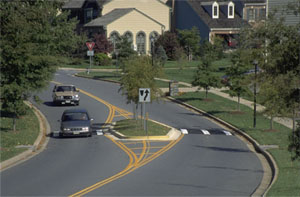
Explanation:
A 12' long hump (like the ones shown in this photo) can be crossed at 12 mph
- Photo Slide: 22' Speed hump
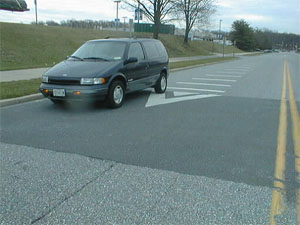
Explanation:
A 22' long hump or table can be crossed at 25 mph (both cause discomfort at
higher speeds). A variety of signing and pavement marking patterns can be
used to warn motorists of the hump.
- Photo Slide: Speed table/crosswalk
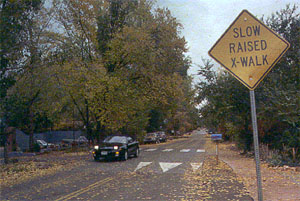
Explanation:
This is a photograph of a speed table combined with a crosswalk.
- PowerPoint Graphic Slide: Pedestrian Crossing, Speed Table and Median Refuge
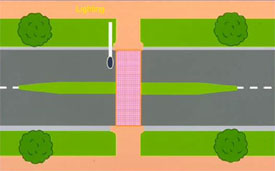
Explanation:
As mentioned earlier, the best approach is to combine several methods...
- Photo Slide:Traffic calming at a pedestrian crossing
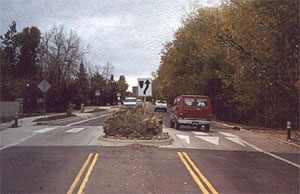
This is a speed table combined with a median to create a "pinch point".
The landscaping in the median also helps to break up the long view down the
street One challenge in designing this type of device is to make sure that
the landscaping does not create a sight distance problem between motorists
and pedestrians.
- PowerPoint Graphic Slide: Slow Point (Chicane) with Speed Hump

Explanation:
This is a solution that breaks up the vista down a long, straight street (with
trees), and at the same time requires motorists to negotiate a curve. This
is also called a chicane.
- Photo Slide: View of an angled slow point

Explanation:
This photo provides an example of how this type of traffic calming device
is put into practice. See how the angled street breaks up what was otherwise
a long vista. What could the designers have done to slow down traffic more
at this location? (answer – make the road narrower – you can see that this
bus isn't having any problem negotiating through this turn, and could probably
do it relatively fast). You can also see the raised crosswalk in the foreground
of the picture.
- Photo Slide: Traffic circle on a neighborhood
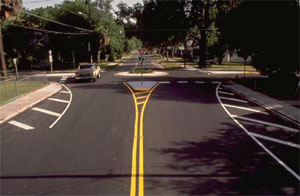
Explanation:
Traffic circles can be used as traffic calming devices at intersections, reducing
vehicle speeds. Mini traffic circles (like the one shown in this photograph)are
raised circular islands constructed in the center of residential street intersections.
They reduce vehicle speeds by forcing motorists to maneuver around them and
are sometimes used instead of stop signs. Traffic circulates counterclockwise
but larger vehicles may have to turn left in front of a circle in order to
successfully maneuver through the intersection. This design works best when
located on residential roads that need traffic calming, but are not slated
for truck use.
- Photo Slide: Roundabout on an arterial street.
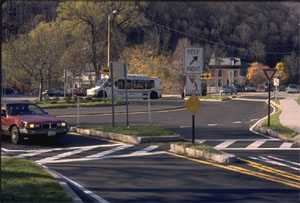
Explanation:
Roundabouts are different from traffic circles or rotaries. Modern roundabouts
follow very specific design guidelines that make them safe and efficient.
They have splitter islands on the approaches, and vehicles that are entering
the roundabout are required to yield to traffic in the circle. They have a
raised circle in the center that usually includes landscaping and occasionally
a truck apron to protect it from damage by large trucks. There is no parking
on the approaches to a modern roundabout.
Several studies in the US, Europe and Australia have found that roundabouts,particularly
single-lane roundabouts, have better overall safety performance than stop
controlled intersections and signalized intersections. In the US,a recent
study showed that for 24 intersections converted to modern roundabouts vehicular
injury crashes decreased by 76%. Pedestrian crashes at these roundabouts also
decreased, however the numbers were too small to be statistically significant.
A Dutch study of 181 roundabouts (generally single-lane roundabouts) found
a reduction of 89% in pedestrian injuries and a reduction of 30% in bicyclist
injuries after conversion.
These safety improvements are primarily the result of a reduction in the number
of potential conflicts (such as right-angle conflicts and left-turn conflicts)and
slower vehicle speeds. At roundabouts, splitter islands separate entering
and exiting traffic at the approaches and serve as pedestrian refuge islands.
This means that pedestrians need only cross one direction of traffic at atime.
There are some issues that can make roundabouts challenging for pedestrians.
Often times, the driver's attention is on the roundabout ahead, rather than
the pedestrian crossing in advance of the roundabout. Since traffic is not
required to come to a full stop while entering the roundabout, pedestrian
crossings at roundabouts can be difficult. It should be noted however, that
motor vehicles are required to yield to pedestrians in the crosswalks.
For pedestrians who are blind or vision impaired, roundabouts may be a confusing
and dangerous place. Pedestrians that are blind are very dependent on the
sounds of starting and stopping traffic when negotiating through an intersection.
With a roundabout, however, traffic does not necessarily stop at the intersection,so
it may be difficult for them to know when they are able to cross, difficult
to tell where traffic is coming from, and to know where there are gaps in
the traffic flow.
Return to top
Page last modified on February 1, 2013
























































